Wildfires are unpredictable, but the risk is real. The last few years have seen larger and more frequent fires. The damage can be – and has been – devastating. Entire towns have been consumed, homes destroyed, and lives lost. We cannot afford to ignore the risk. It is up to all of us to protect what matters.
TAKE CONTROL OF THE RISK
Wildfires spread furiously until one of two things happen—the weather changes drastically or they run out of fuel. The future requires us to focus on what we can control: the fuel. There are
basic preventative measures to safeguard properties. However, even these have their limits during extremely dry or windy conditions.
For over 45 years, Mercedes Textiles Ltd. has delivered water with their WICK® portable pumps and forestry hose for wildland firefighting around the world. Watching wildfires consume entire communities, they feel compelled to do more. Mercedes Textiles have developed the Value Protection pumps to power the last line of defense when the risk hits home.
We know wet fuel won’t burn. When water sources are available, our pumps can provide additional safeguards to mitigate damage to structures & property using water barriers.
With that goal in mind, Mercedes Textiles developed WICK® Value Protection pumps to power the last line of defense when the risk hits home
These pumps feature loss of prime protection, which shuts the engine off if the water source fails, and remote fuel connection. The WICK® 100M also features a unique clutch that will stop water flow when running idle. The three larger pumps also feature electric start with recoil backup.
Engineered for extended runtime, our WICK® Value Protection pumps are ideal to power wildfire mitigation setups such as rooftop and tower sprinklers (see below).
PROVEN PUMPS
WICK® is world-renown in wildland firefighting for water delivery. WICK® Value Protection offers a full line of portable pumps engineered for extended runtime with key features like remote fuel connection, automatic shutoff, unique clutch, and electric start options. From lightweight to high-power, Mercedes Textiles' VP lineup includes pumps of variable pressure & volume performance to supply flexible solutions.
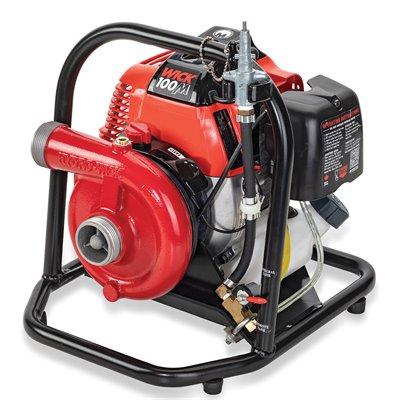
Wick 100M
ULTRA-LIGHTWEIGHT
MAX 105 PSI | MAX 72 GPM
20 GPM @ 80 PSI | 60 GPM @ 30 PSI
Ideal for smaller systems like rooftop sprinklers and hose-lines

WICK SI 300
PORTABLE POWER
MAX 275 PSI | MAX 90 GPM
30 GPM @ 200 PSI | 80 GPM @ 80 PSI
Ideal for mid-size and mid-range systems; flexible to meet a variety of needs
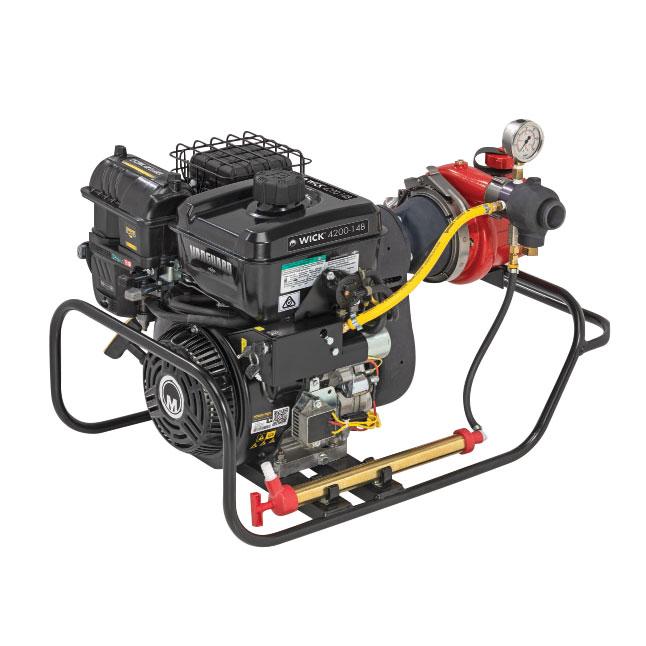
WICK XP4-14
HIGH POWER
MAX 380 PSI | MAX 105 GPM
120 GPM @ 80 PSI | 97 GPM @ 30 PSI
Ideal for larger/expanded systems and locations with farther distance or elevation from the water

WICK UltraFlo
HIGH PRESSURE + HIGH VOLUME
18 HP: 100 GPM @ 140 PSI | 290 GPM @ 30 PSI
23 HP: 140 GPM @ 140 PSI | 300 GPM @ 30 PSI
A high power, heavy duty combination pump capable of flowing 2x more
water than Mercedes' standard 2-stage pump-end. As the top of their Value
Protection lineup, this pump is ideal for industrial or municipal
applications requiring high volume over long distances or elevations.
This level of performance would power multiple tower sprinklers,
extended ground sprinkler lines, and high-flow monitors.
FLEXIBLE SOLUTIONS
WICK® Value Protection pumps can be paired with various sprinkler setups to create water barrier defense against wildfire.
Here we’ve showcased four setup styles, listing the basic benefits and components. These would be customized to meet the unique needs of each property. Mercedes Textiles WICK® Value Protection lineup offers pumps of varying performance levels to meet most system volume and pressure requirements (GPM/PSI).
For any setup, components and requirements will depend on the structure(s), protection area, elevation from and distance to water source, and sprinkler(s) volume/pressure. Once the requirements are calculated, select a pump that offers the necessary performance.
Tower Sprinklers
Ideal for multiple structures or larger properties, tower setups use mounted industrial irrigation sprinklers to offer a wide range of protection (up to 160’ radius per sprinkler).
Within minutes, a water barrier of mist is created, soak all surfaces and preventing combustion. Works best as a permanent or semi-permanent installation.
COMPONENTS:
- Pump Setup
- Discharge Hose
- Tower structure
- Irrigation Sprinkler
SUITABLE PUMPS:
- WICK SI 300
- WICK XP4-14
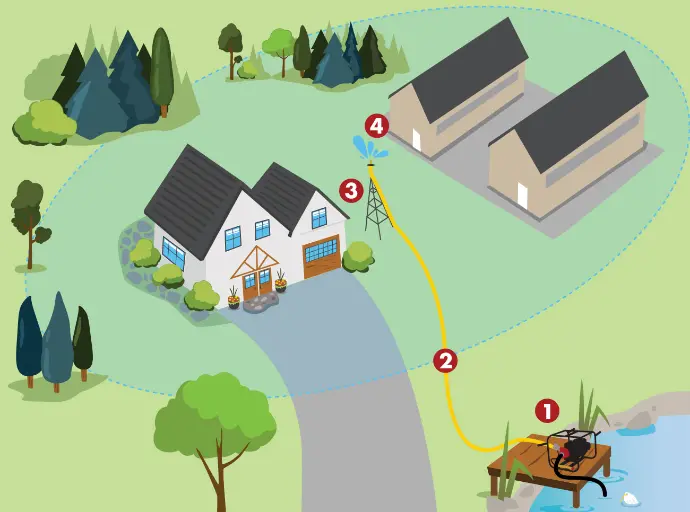
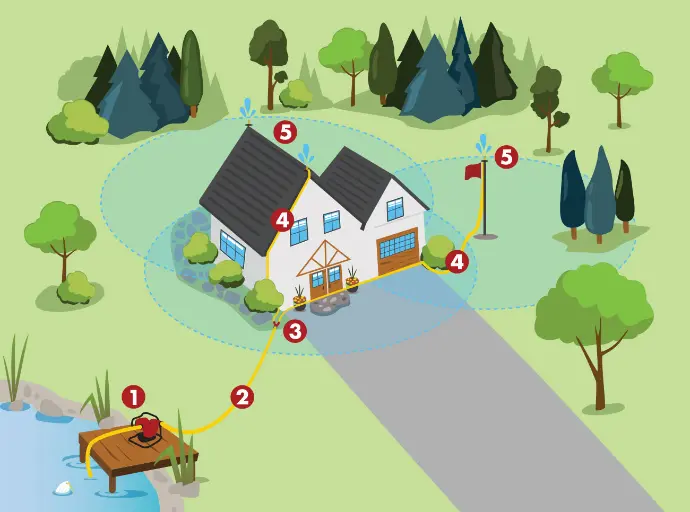
Rooftop Sprinklers
For individual structures or smaller properties, rooftop sprinklers offer a simple setup with an expandable range for quick and effective protection (up to 50’ radius per sprinkler). These setups ideal for homeowners and cottages as permanent, seasonal or temporary installations on rooftops or flagpoles.
COMPONENTS:
- Pump Setup
- Discharge Hose
- Wye / Water Thief
- Sprinkler Hose(s)
- Roof/Pole Mounted Sprinkler(s)
SUITABLE PUMPS:
-
WICK 100M
- WICK SI 300
Ground Sprinklers
For larger properties or open spaces, ground sprinklers create a non-combustible perimeter with a line of multiple sprinklers connected with forestry hose. These setups are easy to
deploy and flexible to be a seasonal or temporary system that can be expanded or relocated as needed (up to 50’ radius per sprinkler).
COMPONENTS:
- Pump Setup
- Discharge Hose
- Wye
- In-Ground Sprinkler(s)
- Sprinkler Hose(s)
SUITABLE PUMPS:
- WICK SI 300
- WICK XP4-14
- WICK UltraFlo
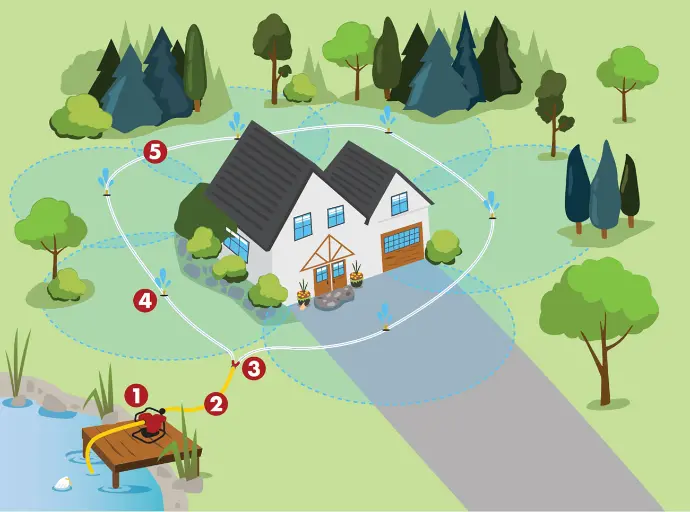
Hoselines/Hydrants
Directly connecting hoseline(s) with nozzles allows for active fire extinguishment or manned defense* . Quick deploy when needed, hoselines are also useful for recreational fire containment. Installing permanent “hydrant” boxes allows for even faster access.
COMPONENTS:
- Pump Setup
- Discharge Hose
- Forestry Nozzle
SUITABLE PUMPS:
- WICK 100M
- WICK SI 300
*Be safe. Always follow evacuation orders.

FREQUENTLY ASKED QUESTIONS
HOW DO WE DETERMINE WHICH SETUP TYPE FITS BEST?
The ideal setup will be based on the property or structure size and type, the location requirements and budget. You should also take into consideration whether the system will be permanent, seasonal, or temporary.
HOW DO WE DETERMINE WHICH PUMP IS REQUIRED?
You will need to calculate the required volume and pressure (GPM @ PSI) to supply adequate water to the sprinkler(s). This requires data from the location, particularly distance and elevation from water source, the required range of the system, and friction loss of the hose(s).